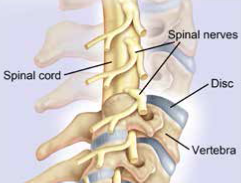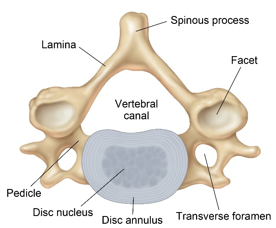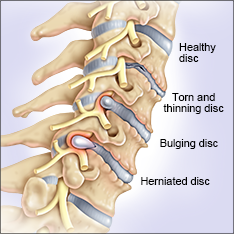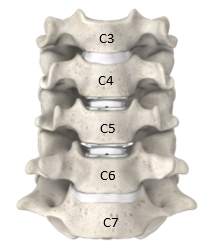
Side-view of a healthy cervical spine

Top-down-view of a one vertebra and disc in the cervical spine

Top-down-view of a one vertebra and disc in the cervical spine

Front view of a cervical spine showing the Mobi-C implanted at two adjacent levels (C4-C5 and C5-C6)
The healthy spine
The top seven vertebrae make up the cervical spine and begin at the base of the skull. The vertebrae of the cervical spine protect the spinal cord and support the skull. A disc between each vertebra helps to cushion the vertebrae from moving together with the load of the body.
Each disc has a strong outer ring (annulus). The outer ring helps keep the disc’s soft center (nucleus) in place. Disc problems can start from over-use, an accident, or just the wear and tear of everyday life.
The degenerated cervical spine with disc bulge or herniation
When a disc degenerates, the disc:
- Loses water. With less water, the disc becomes thinner and has less padding to absorb movement. The disc may become less flexible.
- May have tiny tears or cracks in the outer layer (annulus) of the disc.
Disc degeneration can cause the softer nucleus to squeeze against or through the tougher annulus (disc bulge or disc herniation).
- With a bulging disc, typically a large portion of the annulus expands outward. The disc’s nucleus is still held in place by the annulus.
- With a herniated disc, the annulus has cracked allowing some of the nucleus to push out.
A disc bulge or disc herniation may irritate the spinal cord (myelopathy) or nerve roots (radiculopathy). This can cause a loss of feeling, loss of movement, pain, weakness, or tingling down the arm and possibly into the hands.
The Mobi-C® Cervical Disc is an artificial disc for the neck designed to replace one or two worn out discs while maintaining neck movement. Surgery with Mobi-C is for adults with a damaged disc at one or two adjacent levels from C3-C7. Mobi-C may help end or lessen your pain and discomfort associated with the above conditions.
For a complete description of the risks and benefits associated with cervical spine surgery with Mobi-C, please visit www.cervicaldisc.com/clinical-results.
Ask your doctor:
Non-surgical treatment, such as physical therapy, injections, and possibly a neck brace, will be prescribed first by your doctor. If these treatments do not relieve your pain or dysfunction, you and your doctor may determine that you are a candidate for artificial disc replacement.
Talk to your doctor about the risks and benefits of surgery using the Mobi-C to treat your condition. Surgery with the Mobi-C may help stop your pain and other problems from a damaged cervical disc.
Learn more about Mobi-C.
Am I a candidate for cervical disc replacement with the Mobi-C?
Find a trained Mobi-C surgeon.